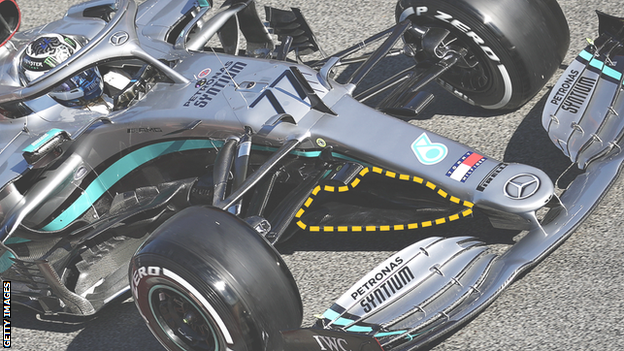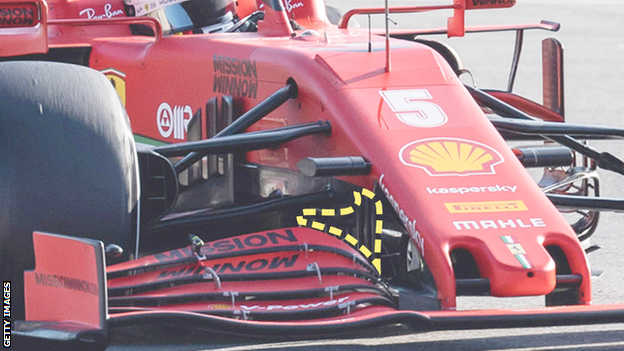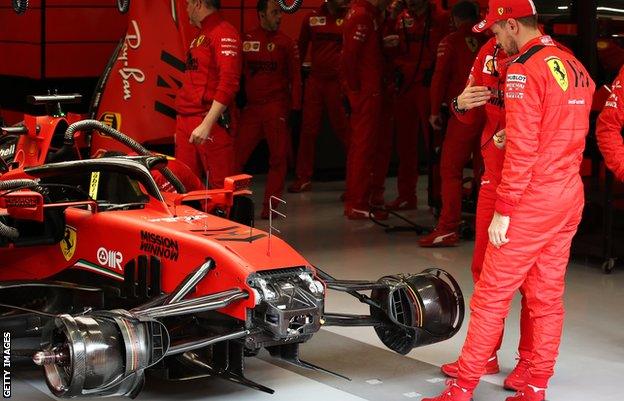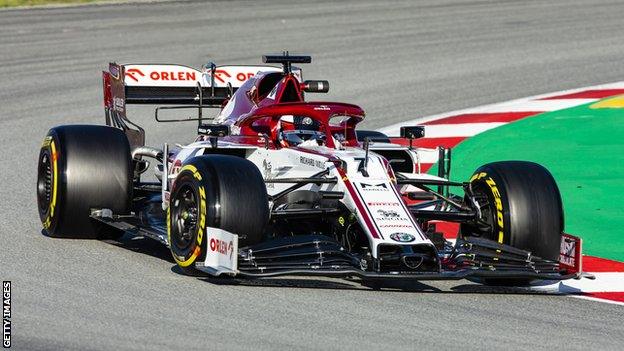Formula 1 2020: The secret aerodynamicist - are capes the key?
- Published

The Austrian Grand Prix is live on 5 Live Sports Extra and the BBC Sport website
Not all superheroes wear capes, but this year Adrian Newey has decided to don his.
Red Bull's renowned design genius has decided to fit his 2020 car with what engineers in Formula 1 call a 'cape'.
This is following a lead by Mercedes, who introduced this aerodynamic component in 2017, and still run it today.
And it's not just Red Bull following Mercedes' lead, either. Renault and Racing Point both have new or updated capes in 2020, too.
Whether a team has chosen to fit a cape - or alternative devices which, although different, are designed to do a similar job - could have significant consequences for the way cars handle and, ultimately, who might come out on top in this year's championship.
I am the secret aerodynamicist. I work in the design department of an F1 team. And I'm going to explain what's so important about these little-known but key devices at the front of F1 cars.

Mercedes use a 'cape' underneath the nose of their car
What is a 'cape'?
The 'cape' is what we call the long flat piece of bodywork that is located just under the car's nose.
Those teams who don't have a cape instead opt for what is known as a 'J vane', so called because of the shape it takes as it hangs under the nose. Notable adopters of the 'J vane' solution are Ferrari and Haas, while the remainder of the field have gone for a little bit of both.
These two aerodynamic devices perform a broadly similar job, but there are some subtleties in the way they work which could have significant consequences for the car's handling and performance.
These devices are interesting because they form part of a larger air-flow system designed to manage and manipulate something called the y250 vortex, which is arguably the key aerodynamic phenomenon on F1 cars of the last decade.

Ferrari prefer the 'J vane' approach
What is the 'y250 vortex'?
In 2009, F1 introduced rules aimed at trying to increase overtaking. Significant changes have been made to the regulations since then, including making the cars wider and much faster. But one key feature has remained throughout.
The rules designate an aerodynamically neutral section of the front wing for the first 250mm out from the centre of the car. Outboard of that, the rules allow more freedom and the front wings become more aerodynamically loaded.
The switch from a neutral section into a part of the wing that teams can shape for aerodynamic effect means there is a sudden change of pressure at this 250mm point.
To try to understand what's happening here, think about the car driving forwards through the air. Or, from the perspective of the car, the air is coming towards it.
The air hits the transition point between the neutral central section of the wing and the downforce-creating parts outside it, and this sets the air off into a corkscrew, spiralling along in a little tornado-like feature which we call a vortex. This is the y250 vortex, named for the distance from the centre-line of the car at which it is created.
This vortex - which streams off both sides of the front wing at the same point - is very powerful and has an effect on pretty much everything that happens behind the front wing.

The y250 vortex causes air to flow over the front wing and spiral toward the chassis
Why is the y250 vortex so important?
One of the first features that the y250 vortex starts to interact with is either the cape, or the J vane, depending on which is fitted.
Now, remember all the air is rotating around the y250 vortex. This is driving air downwards in the middle of the car.
This air hits the edge of the cape or J vane and creates a second vortex, this time rotating in the opposite direction.
This new vortex is absolutely key to the aerodynamics of the whole car.
The reason for this is that the next thing it does is go under the floor. Here, it triggers something a bit like a chain reaction.
The low pressure from this second vortex created by the cape or J vanes interacts with a second area of bodywork - the little flicks and vanes in the area behind the front wheels and ahead of the sidepods, either side of where the driver is sitting. This is known as the 'barge-board area'
All the pieces of bodywork here now start to shed their own vortices, each of which also goes under the floor of the car. Together, they generate an enormous amount of downforce, by speeding up the air under the car and creating a large amount of low pressure, which sucks the car towards the track.
At the same time as the cape vortices are doing this, our old friend the y250 vortex is sitting up above the bargeboard foot, driving air downwards through the aforementioned flicks and vanes.
In doing so, it adds power to the many vortices in this area, making them spin faster and creating even more downforce.
The y250 then continues its journey downstream, much of the energy extracted from it now, and heads around the sidepods of the car.
Why is this so important?
Along with the diffuser at the rear of the car and the front and rear wings, this combined series of vortices - started by the y250 vortex at the front wing, and enhanced by the cape vortex, in turn interacting with the bargeboard vortices - is one of the major downforce generating areas on the car, so it is vital to get it right.
This is why there is such a proliferation of elaborate designs in this part of the car, as each team tries to maximise the downforce available.

Sebastian Vettel checks out his J vane (and possibly wishes it was a cape)
The complexities of controlling the vortices
Optimising the strength and position of the y250 and the cape or J vane vortices is crucial to getting the most out of this part of the car.
Making them as strong as possible is typically beneficial so that they can drive the downforce-generating structures at the front of the floor.
Last year I wrote about the different approaches teams had taken to front wings - the 'inboard-loaded' approach championed by Ferrari and the 'outboard-loaded' of Mercedes. But one factor we didn't discuss was the effect of these on the y250 vortex strength.
An inboard-loaded front wing, such as on the Ferrari, will exaggerate the difference in pressure at the transition point 250mm from the middle of the wing.
This will strengthen the y250 vortex and could be a part of the reason why most teams - even Red Bull and Mercedes, whose front wings retain a slightly different philosophy - have headed in this direction to some degree for this season.
On top of this, you need to balance the strength of the vortices so that they can remain in their optimal positions.
If the y250 vortex is too strong, it can pull the cape/J vane vortex out, away from the bargeboards. If the y250 is too weak, it can get pulled down, under the floor, throwing a spanner into the works of our finely tuned vortex system.

Kimi Raikkonen relies on a car which handles with a well-balanced front end
The pros and cons of capes and j vanes
To create a car that really handles well, consistent positioning of the vortices is vital.
Regardless of whether the car is driving through crosswinds, rolling around corners, or bumping over kerbs, it is important that each vortex stays as close to the optimal position as possible. Otherwise, the amount of downforce, and hence grip, the car has will change from corner to corner, and lap to lap.
This is one thing drivers hate because it affects their confidence and trust in what the car will do, and makes it harder for them to extract the most from the car. It is here that some of the pros and cons of the cape verses the J vane start to emerge.
The J vane inherently has lots of vertical surfaces by virtue of the way it is attached to the nose.
These are great at mitigating some of the effects of crosswinds by straightening out the airflow and aligning it with the direction in which the car is heading. This helps to prevent the y250 vortex from being blown one way or another, keeping it in the same spot.
On the other hand, the cape can more easily be mounted further forwards on the nose. By being as close as possible to the point where the y250 vortex is first formed, it is able to influence the position of that vortex sooner, stopping it from drifting too high or too wide before it is too late to pull it back.
The differences between each strategy are subtle and the advantage of one over the other may not be immediately obvious when starting research.
The best solution will become clear only after months or even years of development and could well be different for different cars.
I certainly wouldn't claim to know which one will definitely give you the fastest racing car. However, opinion in the paddock this year does appear to be leaning towards the cape.
It will be fascinating to see whether Mercedes, Red Bull, and the other caped crusaders find themselves with better handling cars than their J vane-sporting rivals this year.
If they do, expect to see a red car arriving at a grand prix wearing a cape in the not-too-distant future.